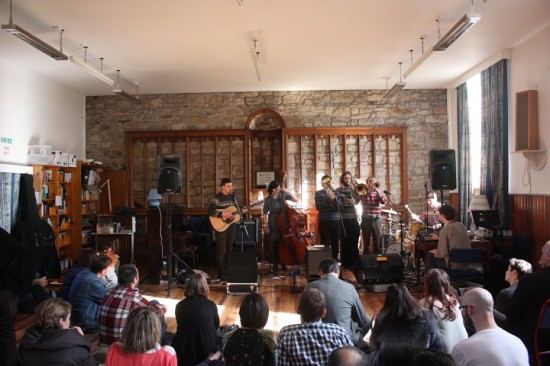 Homegame Festival at the Hew Scott Hall: Copyright Dylan Matthews / Blueback Hotrod
Homegame Festival at the Hew Scott Hall: Copyright Dylan Matthews / Blueback Hotrod
The value of place and space to gig venues: the impending closure of the Bristo Hall and the Hew Scott Hall
by Rob St. John
In a recent lecture for TED, David Byrne discusses a radical theory of the historical evolution of music in relation to the architecture of the venues in which it is performed. Where intimate, palatial rooms in 17th and 18th century houses fostered the development of chamber quartets, the profusion of enormous stadiums hosting live music encouraged bands like U2 to pile on the reverb and delay, catalysing stadium rock.
Following this idea, music evolves to fit the venue in which it is performed. I don’t agree entirely with David, seeing more of a messy, overlapping symbiotic relationship between music and architecture, but what I think you can take from it is the importance of individual spaces on the music that they host. This article will mention two spaces in Scotland that are inextricably interwoven into the music and communities that have grown out of them, and both of which – sadly – are threatened with closure.
 Retreat Festival at the Bristo Hall: Copyright Neil Cammock
Retreat Festival at the Bristo Hall: Copyright Neil Cammock
In Scotland there are a number of healthy DIY music communities that regularly use unconventional spaces to host gigs and exhibitions. In Edinburgh, The Forest, Tracer Trails and others have made good use of a disused city-centre church, The Bristo Hall. A former Adventist church, the Bristo Hall is a large, relatively plain space with no stage, equally adept at hosting minimal acoustic gigs for K Records’ minimalist Little Wings as it is be-masked post-punk noise band The Leg. In the hall, bands swell and sprawl, both sonically and physically, to fill the beautiful space, with the audience and musician bound in a messy, expansive and unstaged squall. Tight, creative communities have sprung up from DIY shows in the Bristo Hall, where the ever-alterable space and lack of barriers between performer, promoter and audience encourages friendly collaboration.
The Hew Scott Hall is in a tiny, 18th century harbourside church space on a narrow, winding street in Anstruther in the East Neuk of Fife. Holding no more than 100 people when full to the rafters, it has been (this year excepted) a central node to the Fence Records Homegame festival. Records, zines and produce from the local bakery http://www.fisheranddonaldson.com/> and Fife Diet are sold in the hall by day, as audience members mingle in and out, and music (see Viking Moses covering Leonard Cohen at 1am to a packed hall for inspiration ) fills the afternoons through to the wee small hours.
Sadly, both these venues are under threat of closure, a similar story to that befalling many British arts venues (and one that would have made for a fitting chapter in Real England, Paul Kingsnorth’s excellent book on wider ideas of British cultural homogenisation through such developments). The Bristo Hall (and wider Forest co-op arts space) is under threat of being sold for redevelopment, where the Hew Scott Hall is falling into disrepair, with the local council unable to meet the estimated £2 million repair costs. These threatened closures were what inspired this article, but their fate also brings up these wider questions of how far setting can inspire, determine or alter the form of the music that it hosts.
I recently saw A Hawk and a Hacksaw play the backroom of a darkened pub in Oxford, a dispiriting experience of a band playing music perfectly suited to informal, unconventional live settings like the Bristo or Hew Scott Hall, stifled by the sound and surroundings. Through fast polkas and wild klezmers, the audience remained unmoved. They stood with arms folded, waiting to be entertained, seemingly bored by the sight of a band of inventive musicians playing music made for dancing. When sound problems forced (however voluntarily) the band into the crowd to play acoustically, the dynamic didn’t change markedly, instead ushering the scattershot pop of satelliting cameras orbiting the hunched, hastily-departing performers. The audience seemed more concerned with endlessly documenting the proceedings (do they not know that Coldplay, Arcade Fire and likely every other MOR rock band are doing this too now?!), and breaking some imagined fourth-wall in climbing onto the deserted stage.
To return to David Byrne’s ideas of music and architecture, the evolution of such standard, staid gig venues isn’t always all that suitable for the music (and associated communities) they now host. This is where using unconventional and reappropriated spaces like churches, halls, galleries, disused shops, etc as an alternative – a practice that’s always bubbled under in the independent pop underground – is so crucial.
Maybe this is an isolated example, and perhaps I’m being overly pessimistic, but this experience brought home just how important spaces like the Bristo Hall and Hew Scott Hall are to me – both as a musician and an audience member. Interesting things thrive on the periphery, and in the unorthodox, where both the audience and the performer are brought out of traditional spaces of staged separation to create something new, unstaged and vital. These spaces are valuable in themselves for the histories they represent. Their reappropriated use by imaginative promoters helps create new meanings, memories and communities based around the arts they now host. They’re beacons against homogenisation of architecture, art and community, and worth saving before – like too many others around the country – they’re lost.
You can find out more about the campaigns to save the Bristo Hall (and Forest arts space) and the Hew Scott Hall here:
Hew Scott Hall
http://www.petitiononline.com/AIA999/petition.html
http://www.guardian.co.uk/edinburgh/2011/apr/19/ian-rankin-fife-anstruther-fence-collective